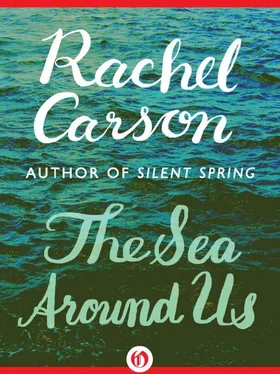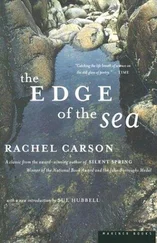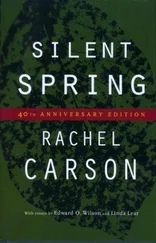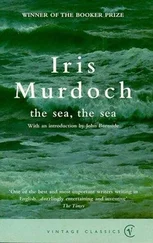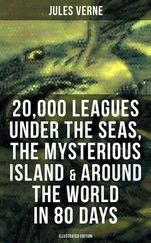On such a night of phosphorescent display Charles Darwin stood on the deck of the Beagle as she plowed southward through the Atlantic off the coast of Brazil.
The sea from its extreme luminousness presented a wonderful and most beautiful appearance [he wrote in his diary]. Every part of the water which by day is seen as foam, glowed with a pale light. The vessel drove before her bows two billows of liquid phosphorus, and in her wake was a milky train. As far as the eye reached the crest of every wave was bright; and from the reflected light, the sky just above the horizon was not so utterly dark as the rest of the Heavens. It was impossible to behold this plain of matter, as it were melted and consuming by heat, without being reminded of Milton’s description of the regions of Chaos and Anarchy. [4] From Charles Darwin’s Diary of the Voyage of H.M.S. Beagle, edited by Nora Barlow, 1934 edition, Cambridge University Press, p. 107.
Like the blazing colors of the autumn leaves before they wither and fall, the autumnal phosphorescence betokens the approach of winter. After their brief renewal of life the flagellates and the other minute algae dwindle away to a scattered few; so do the shrimps and the copepods, the glassworms and the comb jellies. The larvae of the bottom fauna have long since completed their development and drifted away to take up whatever existence is their lot. Even the roving fish schools have deserted the surface waters and have migrated into warmer latitudes or have found equivalent warmth in the deep, quiet waters along the edge of the continental shelf. There the torpor of semi-hibernation descends upon them and will possess them during the months of winter.
The surface waters now become the plaything of the winter gales. As the winds build up the giant storm waves and roar along their crests, lashing the water into foam and flying spray, it seems that life must forever have deserted this place.
For the mood of the winter sea, read Joseph Conrad’s description:
The greyness of the whole immense surface, the wind furrows upon the faces of the waves, the great masses of foam, tossed about and waving, like matted white locks, give to the sea in a gale an appearance of hoary age, lustreless, dull, without gleams, as though it had been created before light itself. [5] From The Mirror of the Sea, Kent edition, 1925, Doubleday-Page, p. 71.
But the symbols of hope are not lacking even in the grayness and bleakness of the winter sea. On land we know that the apparent lifelessness of winter is an illusion. Look closely at the bare branches of a tree, on which not the palest gleam of green can be discerned. Yet, spaced along each branch are the leaf buds, all the spring’s magic of swelling green concealed and safely preserved under the insulating, overlapping layers. Pick off a piece of the rough bark of the trunk; there you will find hibernating insects. Dig down through the snow into the earth. There are the eggs of next summer’s grasshoppers; there are the dormant seeds from which will come the grass, the herb, the oak tree.
So, too, the lifelessness, the hopelessness, the despair of the winter sea are an illusion. Everywhere are the assurances that the cycle has come to the full, containing the means of its own renewal. There is the promise of a new spring in the very iciness of the winter sea, in the chilling of the water, which must, before many weeks, become so heavy that it will plunge downward, precipitating the overturn that is the first act in the drama of spring. There is the promise of new life in the small plantlike things that cling to the rocks of the underlying bottom, the almost formless polyps from which, in spring, a new generation of jellyfish will bud off and rise into the surface waters. There is unconscious purpose in the sluggish forms of the copepods hibernating on the bottom, safe from the surface storms, life sustained in their tiny bodies by the extra store of fat with which they went into this winter sleep.
Already, from the gray shapes of cod that have moved, unseen by man, through the cold sea to their spawning places, the glassy globules of eggs are rising into the surface waters. Even in the harsh world of the winter sea, these eggs will begin the swift divisions by which a granule of protoplasm becomes a living fishlet.
Most of all, perhaps, there is assurance in the fine dust of life that remains in the surface waters, the invisible spores of the diatoms, needing only the touch of warming sun and fertilizing chemicals to repeat the magic of spring.
Where great whales come sailing by,
Sail and sail, with unshut eye.
MATTHEW ARNOLD
BETWEEN THE SUNLIT surface waters of the open sea and the hidden hills and valleys of the ocean floor lies the least-known region of the sea. These deep, dark waters, with all their mysteries and their unsolved problems, cover a very considerable part of the earth. The whole world ocean extends over about three-fourths of the surface of the globe. If we subtract the shallow areas of the continental shelves and the scattered banks and shoals, where at least the pale ghost of sunlight moves over the underlying bottom, there still remains about half the earth that is covered by miles-deep, lightless water, that has been dark since the world began.
This region has withheld its secrets more obstinately than any other. Man, with all his ingenuity, has been able to venture only to its threshold. Wearing a diving helmet, he can walk on the ocean floor about 10 fathoms down. He can descend to an extreme limit of about 500 feet in a complete diving suit, so heavily armored that movement is almost impossible, carrying with him a constant supply of oxygen. Only two men in all the history of the world have had the experience of descending, alive, beyond the range of visible light. These men are William Beebe and Otis Barton. In the bathysphere, they reached a depth of 3028 feet in the open ocean off Bermuda, in the year 1934. Barton alone, in a steel sphere known as the benthoscope, descended to the great depth of 4500 feet off California, in the summer of 1949. [6] From The Depths of the Ocean, by Sir John Murray and Johan Hjort, 1912 edition, Macmillan & Co., p. 649.
Although only a fortunate few can ever visit the deep sea, the precise instruments of the oceanographer, recording light penetration, pressure, salinity, and temperature, have given us the materials with which to reconstruct in imagination these eerie, forbidding regions. Unlike the surface waters, which are sensitive to every gust of wind, which know day and night, respond to the pull of sun and moon, and change as the seasons change, the deep waters are a place where change comes slowly, if at all. Down beyond the reach of the sun’s rays, there is no alternation of light and darkness. There is rather an endless night, as old as the sea itself. For most of its creatures, groping their way endlessly through its black waters, it must be a place of hunger, where food is scarce and hard to find, a shelterless place where there is no sanctuary from ever-present enemies, where one can only move on and on, from birth to death, through the darkness, confined as in a prison to his own particular layer of the sea.
They used to say that nothing could live in the deep sea. It was a belief that must have been easy to accept, for without proof to the contrary, how could anyone conceive of life in such a place?
A century ago the British biologist Edward Forbes wrote: ‘As we descend deeper and deeper into this region, the inhabitants become more and more modified, and fewer and fewer, indicating our approach to an abyss where life is either extinguished, or exhibits but a few sparks to mark its lingering presence.’ Yet Forbes urged further exploration of ‘this vast deep-sea region’ to settle forever the question of the existence of life at great depths.
Читать дальше
